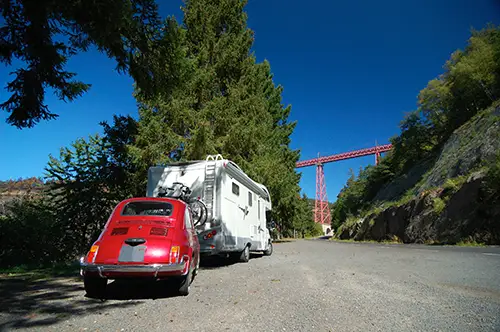
If you’re interested in potentially towing a vehicle on your next trip, learn what it takes to tow a vehicle with your RV.
1: MAKE SURE YOU WON’T EXCEED YOUR RV’S CAPABILITIES
Before you hitch your car to the back of the RV, take the time to find your motorhome’s tow rating. Your maximum towing capacity can be found in your owner’s manual and will indicate the total amount of weight your RV is capable of hauling. Never exceed this amount when you hook up a vehicle to your motorhome.
You also need to pay attention to the Gross Vehicle Weight Rating (GVWR) of your RV. This number indicates the maximum weight your RV can safely transport. You don’t need to count the weight of the vehicle you are towing towards this number, but you do need to include the weight of the trailer tongue, as well as anything else that your RV will be holding.
The next step is to check how much your RV is capable of hauling by looking for a plate on your RV’s hitch that lists this number.
2: DETERMINE HOW YOUR VEHICLE OR “TOAD” CAN BE TOWED
Did you know that the vehicle you tow behind your RV is often referred to as a “toad?”Just as you need to be careful to ensure that you do not exceed your RV’s towing capacity, you also need to make sure that you understand the best way to tow your secondary vehicle.
Please note that not all vehicles can be pulled behind an RV using the same method. For example, many all-wheel-drive and four-wheel-drive vehicles cannot be flat-towed — towed with all four wheels on the ground — behind an RV. This is because it will cause damage to the transmission.
In other cases, there may be critical cooling systems or protections that only kick on when your vehicle is running. Towing these vehicles with all four wheels on the ground can permanently damage major components.
Be sure to consult your owner’s manual to find the manufacturer's recommendation for towing. This should indicate whether you can tow your vehicle on all four wheels, with two wheels down, or if it must be towed on a flatbed trailer. If you cannot find this information readily, speak to your mechanic about the best option based on your vehicle's make, year, and model.
3: CHECK YOUR HITCH
Once you understand how much weight your RV can tow and how your particular vehicle should be towed, it is time to inspect the hitch on your motorhome. Most RVs come equipped with a hitch featuring a ball and a receiver.
If your RV does not have a hitch, there are options for adding a custom hitch to the motorhome. However, be sure to read over any warranty information before adding a hitch to your RV. In some cases, adding a hitch can invalidate your warranty.
4: CHOOSE YOUR STYLE OF TOWING
There are three main methods for towing a vehicle behind your RV. Depending on your toad, you might be limited in which options you can use. Before you try any of these methods, be sure to speak with your mechanic.
FOUR-DOWN OR FLAT TOWING
One of the easiest ways to tow a vehicle behind your RV is using the four-down method, also called dinghy towing or flat towing. This method uses a small tow bar to connect your vehicle to the RV. All four tires rest on the ground, and the vehicle simply trails behind your RV.
This method is a popular choice due to the ease of connecting and disconnecting the vehicle and the limited amount of equipment needed. However, it is not a valid option for all vehicles and causes the most wear and tear on your toad.
TOW DOLLY
Another option for towing your vehicle is to connect a tow dolly to your RV. With this method, the front two wheels of your toad are loaded onto the dolly. The rear wheels roll on the ground. This is a good choice for vehicles with front-wheel drive transmissions. It is a little more complicated to load your vehicle on a tow dolly than to simply use a tow bar, but tow dollies are still a relatively affordable option.
TRAILER
For all-wheel-drive or four-wheel-drive vehicles, you’ll most likely need to tow your vehicle with a trailer or car hauler. In this case, you will drive your vehicle onto the trailer and tow the vehicle with no wheels touching the ground.
Trailers are the most expensive option. However, they offer the best protection for the vehicle you are towing. Because the wheels are not touching the ground when in transit, you will not wear down the tires, and there is no risk to the components of your vehicle.
Source: transwest.com

